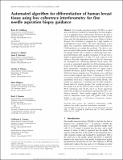| dc.contributor.author | Goldberg, Brian D. | |
| dc.contributor.author | Iftimia, Nicusor V. | |
| dc.contributor.author | Bressner, Jason E. | |
| dc.contributor.author | Pitman, Martha B. | |
| dc.contributor.author | Halpern, Elkan | |
| dc.contributor.author | Bouma, Brett E. | |
| dc.contributor.author | Tearney, Guillermo J. | |
| dc.date.accessioned | 2012-02-15T19:24:51Z | |
| dc.date.available | 2012-02-15T19:24:51Z | |
| dc.date.issued | 2008-02 | |
| dc.date.submitted | 2007-08 | |
| dc.identifier.issn | 1083-3668 | |
| dc.identifier.issn | 1560-2281 | |
| dc.identifier.uri | http://hdl.handle.net/1721.1/69119 | |
| dc.description.abstract | Fine needle aspiration biopsy (FNAB) is a rapid and cost-effective method for obtaining a first-line diagnosis of a palpable mass of the breast. However, because it can be difficult to manually discriminate between adipose tissue and the fibroglandular tissue more likely to harbor disease, this technique is plagued by a high number of nondiagnostic tissue draws. We have developed a portable, low coherence interferometry (LCI) instrument for FNAB guidance to combat this problem. The device contains an optical fiber probe inserted within the bore of the fine gauge needle and is capable of obtaining tissue structural information with a spatial resolution of 10 μm over a depth of approximately 1.0 mm. For such a device to be effective clinically, algorithms that use the LCI data must be developed for classifying different tissue types. We present an automated algorithm for differentiating adipose tissue from fibroglandular human breast tissue based on three parameters computed from the LCI signal (slope, standard deviation, spatial frequency content). A total of 260 breast tissue samples from 58 patients were collected from excised surgical specimens. A training set (N = 72) was used to extract parameters for each tissue type and the parameters were fit to a multivariate normal density. The model was applied to a validation set (N = 86) using likelihood ratios to classify groups. The overall accuracy of the model was 91.9% (84.0 to 96.7) with 98.1% (89.7 to 99.9) sensitivity and 82.4% (65.5 to 93.2) specificity where the numbers in parentheses represent the 95% confidence intervals. These results suggest that LCI can be used to determine tissue type and guide FNAB of the breast. | en_US |
| dc.description.sponsorship | Medical Free Electron Laser program (Grant No. FA9550-04-1-0079) | en_US |
| dc.description.sponsorship | National Institutes of Health (U.S.) (Ruth L. Kirschstein individual fellowship Grant No. 1 F31 EB005141–01A2) | en_US |
| dc.language.iso | en_US | |
| dc.publisher | SPIE - International Society for Optical Engineering | en_US |
| dc.relation.isversionof | http://dx.doi.org/10.1117/1.2837433 | en_US |
| dc.rights | Article is made available in accordance with the publisher's policy and may be subject to US copyright law. Please refer to the publisher's site for terms of use. | en_US |
| dc.source | SPIE | en_US |
| dc.title | Automated algorithm for differentiation of human breast tissue using low coherence interferometry for fine needle aspiration biopsy guidance | en_US |
| dc.type | Article | en_US |
| dc.identifier.citation | Goldberg, Brian D. et al. “Automated Algorithm for Differentiation of Human Breast Tissue Using Low Coherence Interferometry for Fine Needle Aspiration Biopsy Guidance.” Journal of Biomedical Optics 13.1 (2008): 014014. Web. 15 Feb. 2012. © 2008 SPIE - International Society for Optical Engineering | en_US |
| dc.contributor.department | Harvard University--MIT Division of Health Sciences and Technology | en_US |
| dc.contributor.approver | Bouma, Brett E. | |
| dc.contributor.mitauthor | Tearney, Guillermo J. | |
| dc.contributor.mitauthor | Goldberg, Brian D. | |
| dc.contributor.mitauthor | Bouma, Brett E. | |
| dc.relation.journal | Journal of Biomedical Optics | en_US |
| dc.eprint.version | Final published version | en_US |
| dc.type.uri | http://purl.org/eprint/type/JournalArticle | en_US |
| eprint.status | http://purl.org/eprint/status/PeerReviewed | en_US |
| dspace.orderedauthors | Goldberg, Brian D.; Iftimia, Nicusor V.; Bressner, Jason E.; Pitman, Martha B.; Halpern, Elkan; Bouma, Brett E.; Tearney, Guillermo J. | en |
| mit.license | PUBLISHER_POLICY | en_US |
| mit.metadata.status | Complete | |
